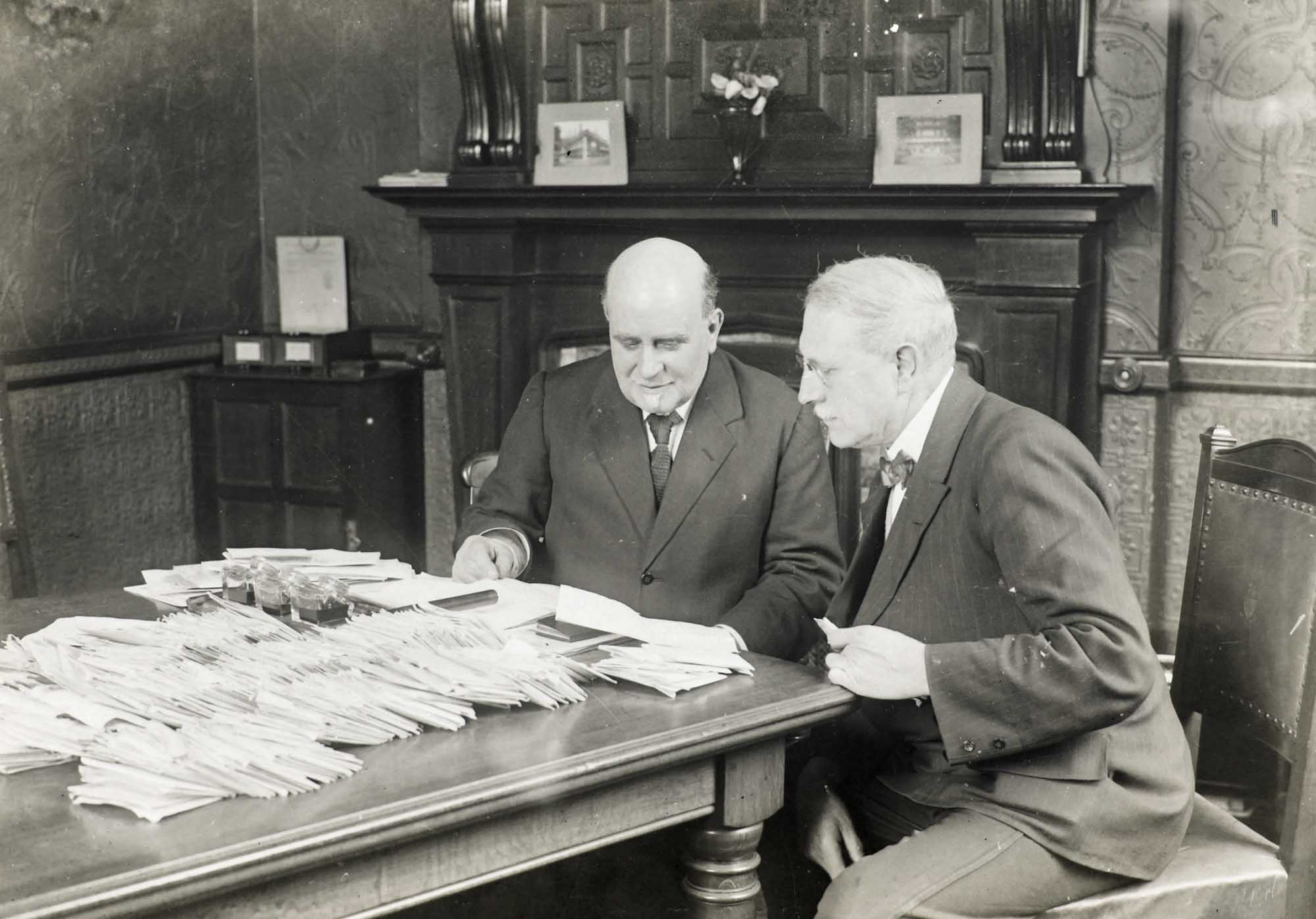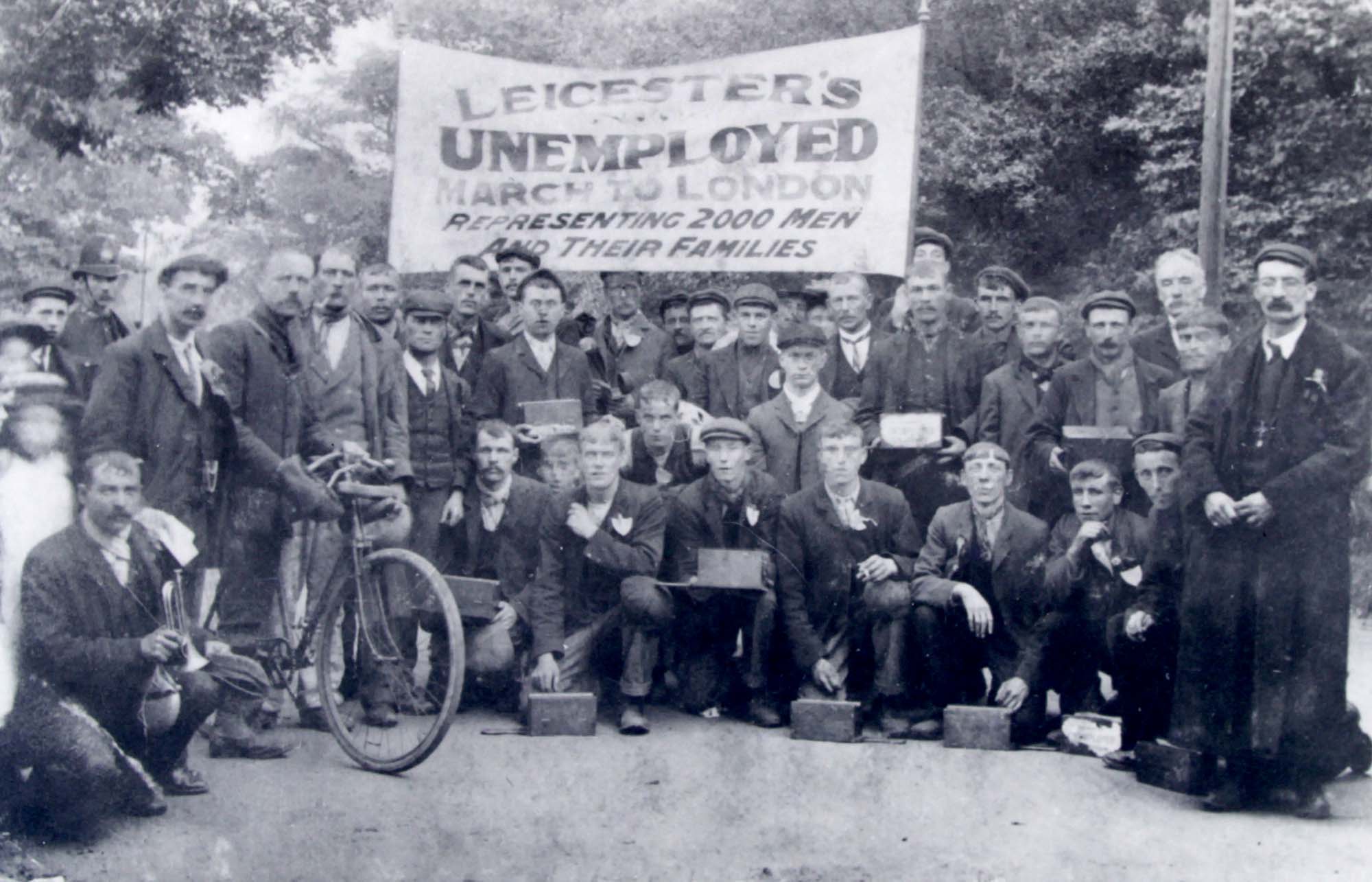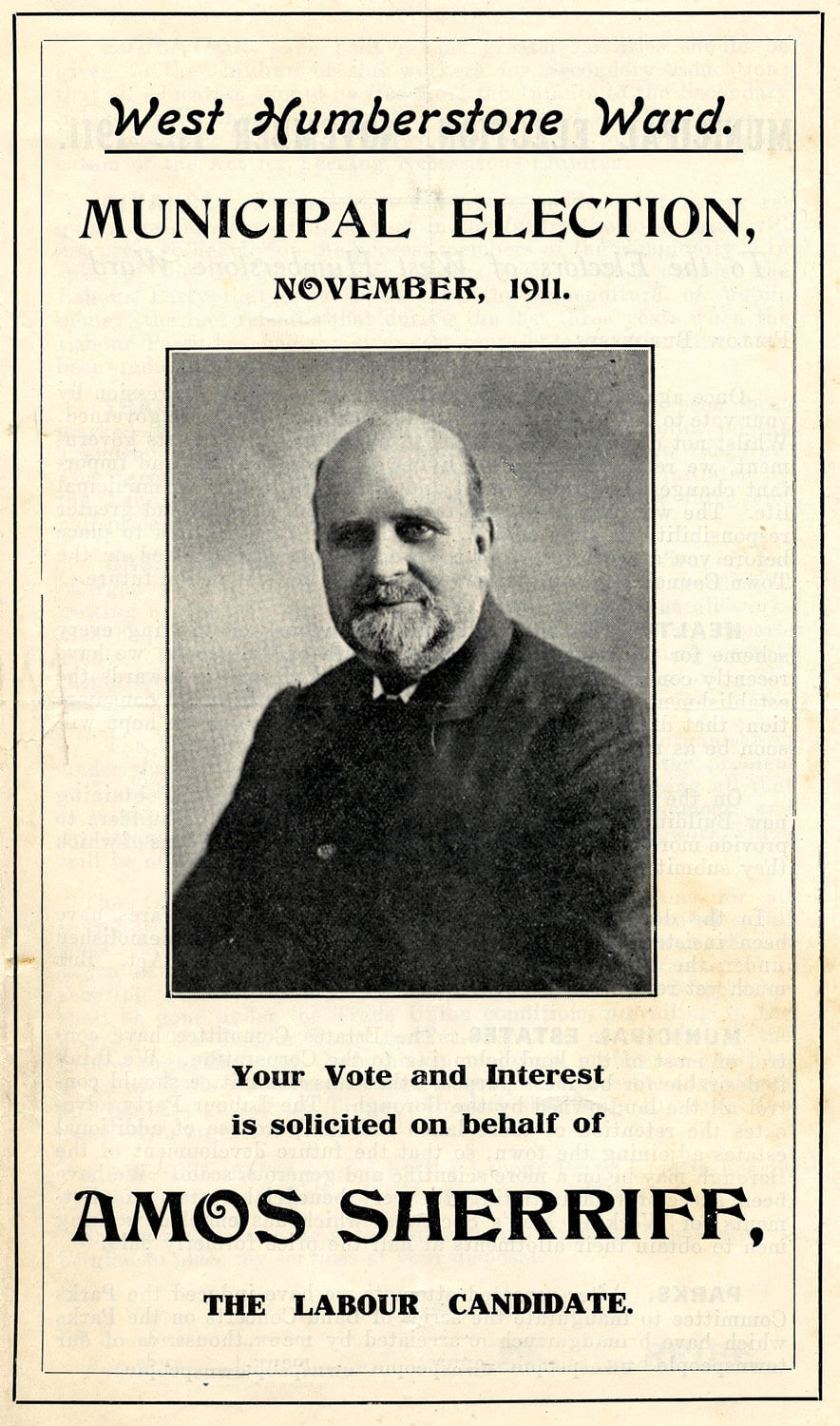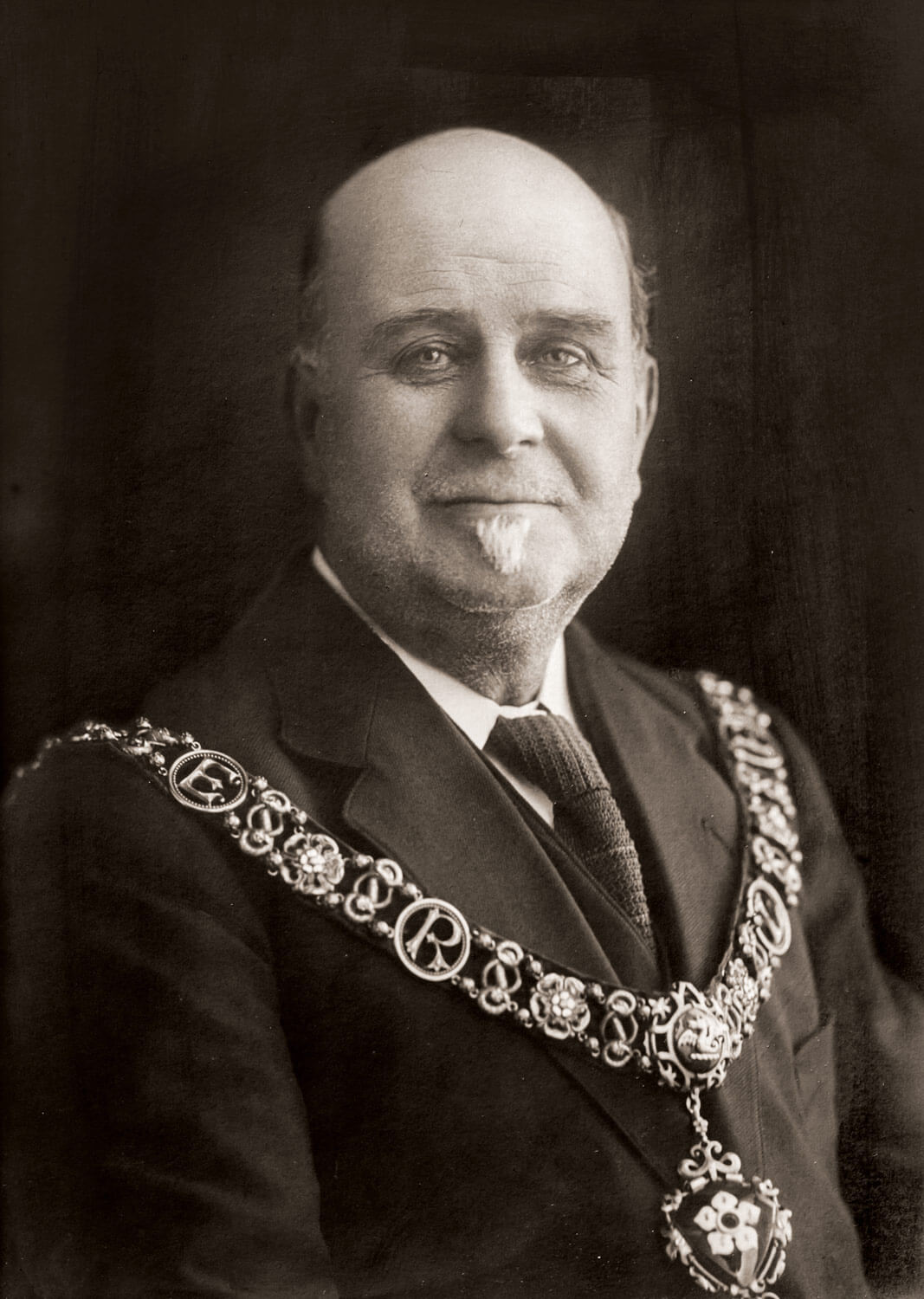- Amos Sherriff started work aged 6 in the Spinney Hill Brick Works and was unable to read or write until in his 20s
- In 1922 Amos Sherriff was elected Lord Mayor of Leicester, the first to represent the Labour Party.
- Amos Sherriff was one of the driving forces behind the 1905 Leicester Unemployed March to London
Champion of the Disadvantaged
A humble beginning in Leicester’s slums
The story of Amos Sherriff is one of remarkable achievement in the face of severe adversity. He was born on 6th January 1856 at 23 Russell Street, near Wharf Street, one of the poorest areas of Leicester, and quite accurately described in the mid-nineteenth century as a slum. His father, William Sherriff, was a glove framework knitter. Amos never went to school. When he was six years of age he was already at work, helping to supplement the family income. He could neither read nor write until he was in his early twenties, and for over twenty years he worked in Fielding Moore’s brickworks in Spinney Hill, once attracting attention by making no less than 700 bricks in one hours.
Family sorrow
In 1874, he married Mary Ann Pitts. Tragically, she died only three years later at the age of twenty-two years, after having had two children, Mary Ann (in 1876) and Emma. It seems likely that she died in childbirth and that Emma also failed to survive. Amos, in his early twenties, was left to come to terms with the loss of his wife and daughter, and to care and provide for his surviving infant child.
A preacher for the Salvation Army
Amos clearly found meaning and purpose in the work of the Salvationists. The Salvation Army, then known as the Christian Mission, first opened its doors in Leicester in 1876 in Foundry Lane. For seventeen years, he preached on the streets of the Wharf Street area and supported the people around him. It is probable that the experience he gained with the Salvation Army honed his ability to lead others and to speak effectively and with assurance in public. It was also through the Salvation Army that he learnt to read and write in his 20s. In 1881, the Salvationists of Foundry Lane established the first Salvation Army band in the country, and Sherriff joined it, having learned to play the cornet.
It is possible that Joseph Merrick, sometimes also known as the ‘Elephant Man’, who was born nearby in Lee Street in 1862, heard Sherriff speak between 1877 and when he entered the Leicester Workhouse in 1879. At this time, despite their charitable work, the Salvation Army faced hostility. It is said that Sherriff sometime returned home covered with blood and mud, having been pelted with stones.

One of the greatest civic and political figures in Leicester
It was from these very humble beginnings that Amos Sherriff was to become one of the greatest civic and political figures in Leicester. In 1908, he became an Alderman, representing the West Humberstone Ward, and in 1922 he was elected Lord Mayor of Leicester, the first to represent the Labour Party.
Socialism and the Independent Labour Party
It was the socialist oratory of Tom Barclay that changed the way in which Sherriff was to work to improve the lives of Leicester’s poor and unemployed. Barclay, just four years his senior, was also born in Leicester to impoverished parents, received no formal education and was put out to work by the age of eight years. After a lecture on Art and Socialism by William Morris to the Secular Society in Leicester, in January 1885, Barclay became a founding member of the Leicester branch of the Socialist League. In the years that followed, he was a committed and active propagandist speaking wherever he could find a platform. Having attended a lecture given by Barclay, Sherriff left the Salvation Army and became a reserve executive member of the Leicester branch of the Independent Labour Party at its formation.
A political surgery in a bicycle shop
Unlike Barclay, who was a confirmed atheist, Sherriff retained his Christian beliefs as well as his support for the Temperance Movement. He opened a cycle shop on Belgrave Road, not far from where he had been born, where people used to call to discuss their problems and seek his advice.
The Clarion Cycle and British Socialism
The Clarion was a weekly newspaper founded in Manchester in 1891 promoting British Socialist ideologies. In time, its readership sought fellowship with one another by creating groups with shared interests such as drama, rambling, singing and cycling. Sherriff became a central figure in the Leicester Clarion Group, his bicycle shop becoming a convenient outlet for the official Clarion Cycle. Clarion 'scouts' on bicycles became an effective means of distributing the newspaper.
The Clarion Cycling Clubs, which became established across the country and overseas, were to become a part of the diverse legacy of the newspaper which folded in 1931. Their objects were 'to protect and further the interests of cycling and cyclists, to promote Mutual Aid, Good Fellowship and support for the Principles of Socialism.'
The March of the Unemployed to London 1905
Determined to take the fight against unemployment and poverty to the nation’s leaders, in 1905, Sherriff was a leader, with the Revd Frederick Donaldson and trade union leader George ‘Sticky’ White, of the Leicester March of the Unemployed. Arguably, Sherriff was the real motivational force behind this protest, as at first the trade unions were not supportive of the idea, and needed to be persuaded. Whilst the marchers undoubtedly gained much sympathy, and publicity, they failed in their aims of directly addressing the Government and the monarchy.

Supporting the unemployed of Leicester
As an alderman, Amos Sherriff continued his work to support the poor and unemployed, but his approach changed from direct protest to working within the systems to provide practical relief. He became a member of the Leicester Board of Guardians and later served as their Chairman. In the 1920s, as Chairman of the Distress Committee, he created a scheme by which unemployed men were given a certain number of hours of employment each week according to the size of their families. He was also instrumental in working against the system which penalised the poor and treated them as a separate part of the community by making them queue in public places such as the market, to be ‘tested’ to see if they qualified for help. The same system disenfranchised the poor by removing their right to vote if they accepted help. He also served as a Justice of the Peace.
Campaign to reform the Workhouse
As the processes for dealing with poverty and unemployment gradually changed, Sherriff worked with the new bodies. He campaigned to renovate the Leicester Workhouse, and to bring humanity to a system which had been designed to be harsh and unforgiving. His work had tangible results in freeing the streets of Leicester from the marches and protests of the unemployed which were happening elsewhere. Indeed, other cities sent delegations to see how Leicester had solved the problems.
An end to a prolific public life
Sherriff was also a prime mover in Leicester's campaign to become a city, which it achieved in 1919. He resigned from the Corporation at the grand age of eighty-seven years and died in May 1945, fittingly perhaps, during a visit to the Workhouse. An Educational Memorial Prize in his name was set up by the Corporation in 1946.
Gallery



Leicestershire Record Office

Leicestershire Record Office
Roman Leicester
(47- 500) A military fort was erected, attracting traders and a growing civilian community to Leicester (known as Ratae Corieltauvorum to the Romans). The town steadily grew throughout the reign of the Romans.
Medieval Leicester
(500 – 1500) The early years of this period was one of unrest with Saxon, Danes and Norman invaders having their influences over the town. Later, of course, came Richard III and the final battle of the Wars of the Roses was fought on Leicester’s doorstep.
-
The Castle Motte1068

-
Leicester Cathedral1086

-
St Mary de Castro1107

-
Leicester Abbey1138

-
Leicester Castle1150

-
Grey Friars1231

-
The Streets of Medieval Leicester1265

-
Leicester Market1298

-
Trinity Hospital and Chapel1330

-
Bow Bridgecirca 1350

-
Church of the Annunciation1353

-
John O’Gaunt’s Cellar1361

-
St John's Stone1381

-
Leicester Guildhall1390

-
The Magazine1400

-
The Blue Boar Inn1400

-
The High Cross1577

Tudor & Stuart Leicester
(1500 – 1700) The wool trade flourished in Leicester with one local, a former mayor named William Wigston, making his fortune. During the English Civil War a bloody battle was fought as the forces of King Charles I laid siege to the town.
Georgian Leicester
(1700 – 1837) The knitting industry had really stared to take hold and Leicester was fast becoming the main centre of hosiery manufacture in Britain. This new prosperity was reflected throughout the town with broader, paved streets lined with elegant brick buildings and genteel residences.
-
Great Meeting Unitarian Chapel1708

-
The Globe1720

-
17 Friar Lane1759

-
Black Annis and Dane Hills1764

-
Leicester Royal Infirmary1771

-
New Walk1785

-
Freemasons’ Hall1790

-
Gaols in the City1791

-
Friars Mill1794

-
City Rooms1800

-
Development of Highfields1800

-
Wesleyan Chapel1815

-
20 Glebe Street1820

-
Charles Street Baptist Chapel1830

-
Glenfield Tunnel1832

-
James Cook1832

Victorian Leicester
(1837 – 1901) The industrial revolution had a huge effect on Leicester resulting in the population growing from 40,000 to 212,000 during this period. Many of Leicester's most iconic buildings were erected during this time as wealthy Victorians made their mark on the town.
-
Leicester Union Workhouse1839

-
Campbell Street and London Road Railway Stations1840

-
The Vulcan Works1842

-
Belvoir Street Chapel1845

-
Welford Road Cemetery1849

-
Leicester Museum & Art Gallery1849

-
King Street1850

-
Cook’s Temperance Hall & Hotel1853

-
Amos Sherriff1856

-
Weighbridge Toll Collector’s House1860

-
4 Belmont Villas1862

-
Top Hat Terrace1864

-
Corah and Sons - St Margaret's Works1865

-
Kirby & West Dairy1865

-
The Clock Tower1868

-
Wimbledon Works1870

-
The Leicestershire Banking Company1871

-
St Mark’s Church and School1872

-
Victorian Turkish Baths1872

-
The Town Hall1876

-
Central Fire Stations1876

-
Aylestone Road Gas Works and Gas Museum1879

-
Gas Workers Cottages1879

-
Leicestershire County Cricket Club1879

-
Welford Road Tigers Rugby Club1880

-
Secular Hall1881

-
Development of Highfields1800

-
Abbey Park1881

-
Abbey Park Buildings1881

-
Victoria Park and Lutyens War Memorial1883

-
Leicester Fosse FC 18841884

-
Leicester Coffee and Cocoa Company Coffee Houses1885

-
St Barnabas Church and Vicarage1886

-
Abbey Pumping Station1891

-
Luke Turner & Co. Ltd.1893

-
West Bridge Station1893

-
Thomas Cook Building1894

-
The White House1896

-
Alexandra House1897

-
Leicester Boys Club1897

-
Grand Hotel and General Newsroom1898

-
Highfield Street Synagogue1898

-
Western Park1899

-
Asfordby Street Police Station1899

-
Leicester Central Railway Station1899

Edwardian Leicester
(1901 – 1910) Electric trams came to the streets of Leicester and increased literacy among the citizens led to many becoming politicised. The famous 1905 ‘March of the Unemployed to London’ left from Leicester market when 30,000 people came to witness the historic event.
-
YMCA Building1900

-
The Palace Theatre1901

-
Pares's Bank1901

-
Coronation Buildings1902

-
Halfords1902

-
High Street1904

-
George Biddles and Leicester's Boxing Heritage1904

-
Municipal Library1905

-
Leicester Boys Club1897

-
The Marquis Wellington1907

-
Guild Hall Colton Street1909

-
Women's Social and Political Union Shop1910

-
Turkey Café1901

Early 20th Century Leicester
(1910 – 1973) The diverse industrial base meant Leicester was able to cope with the economic challenges of the 1920s and 1930s. New light engineering businesses, such as typewriter and scientific instrument making, complemented the more traditional industries of hosiery and footwear manufacturing.
-
Dryad Handicrafts1912

-
De Montfort Hall1913

-
Leicester During the First World War1914

-
Fox’s Glacier Mints1918

-
Statue of Liberty1919

-
Housing in Saffron Lane1924

-
Winstanley House1925

-
Housing in North Braunstone1926

-
Lancaster Road Fire Station1927

-
The Little Theatre1930

-
Saffron Hill Cemetery1931

-
Braunstone Hall Junior School1932

-
Former City Police Headquarters1933

-
Savoy Cinema1937

-
Eliane Sophie Plewman1937
-
City Hall1938

-
Athena - The Odeon Cinema1938

-
The Blitz in Highfields1940

-
Freeman, Hardy and Willis - Leicester Blitz1940

-
Leicester Airport1942

-
Leicester’s Windrush Generations1948

-
Netherhall Estate1950
-
Housing at Eyres Monsell1951

-
Silver Street and The Lanes1960

-
Bostik1960

-
Auto-Magic Car Park (Lee Circle)1961

-
University of Leicester Engineering Building1963

-
Sue Townsend Theatre1963

-
Central Mosque1968

-
Belgrave Flyover1973

Modern Leicester
(1973 – present day) Industry was still thriving in the city during the 1970s, with the work opportunities attracting many immigrants from all over the world. While industry has declined in recent years, excellent transport links have made Leicester an attractive centre for many businesses. The City now has much to be proud of including its sporting achievements and the richness of its cultural heritage and diversity.
-
Haymarket Theatre1973

-
The Golden Mile1974

-
Acting Up Against AIDS1976

-
Belgrave Neighbourhood Centre1977

-
Diwali in Leicester1983

-
Leicester Caribbean Carnival1985

-
Samworth Brothers1986

-
Jain Centre1988

-
Guru Nanak Dev Ji Gurdwara1989

-
King Power Stadium2002

-
LCB Depot2004

-
Curve2008

-
BAPS Shri Swaminarayan Mandir2011

-
Makers Yard2012

- Roman Leicester
- Medieval Leicester
- Tudor & Stuart Leicester
- Georgian Leicester
- Victorian Leicester
- Edwardian Leicester
- Early 20th Century Leicester
- Modern Leicester
Civic Affairs















































































































































